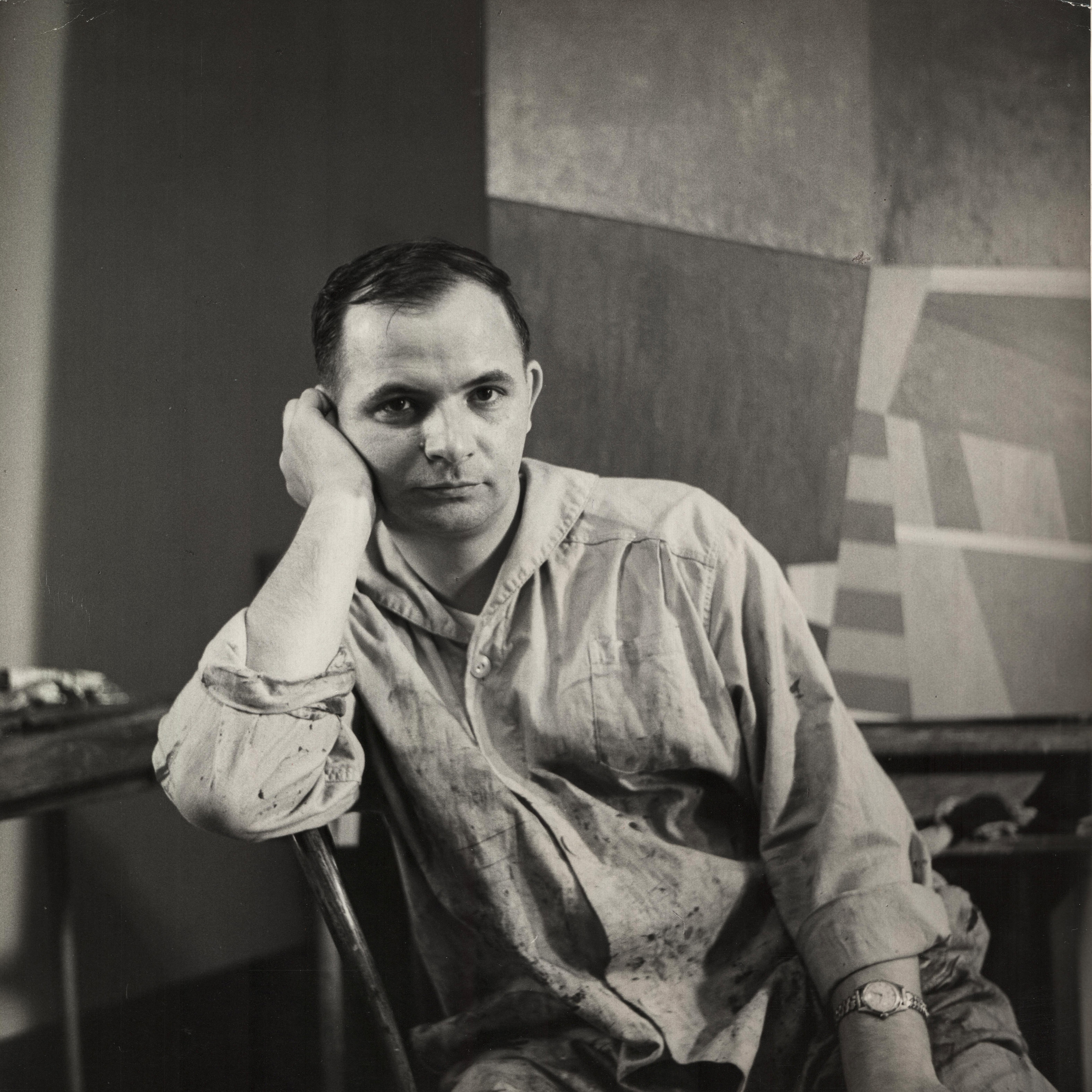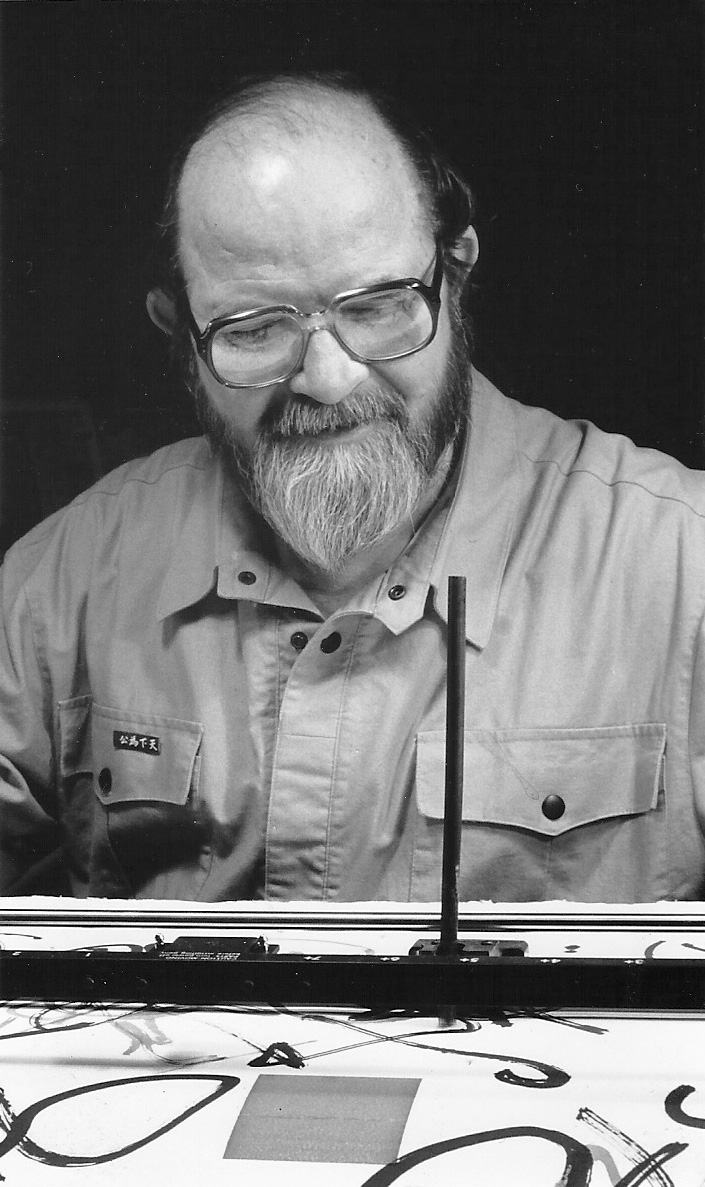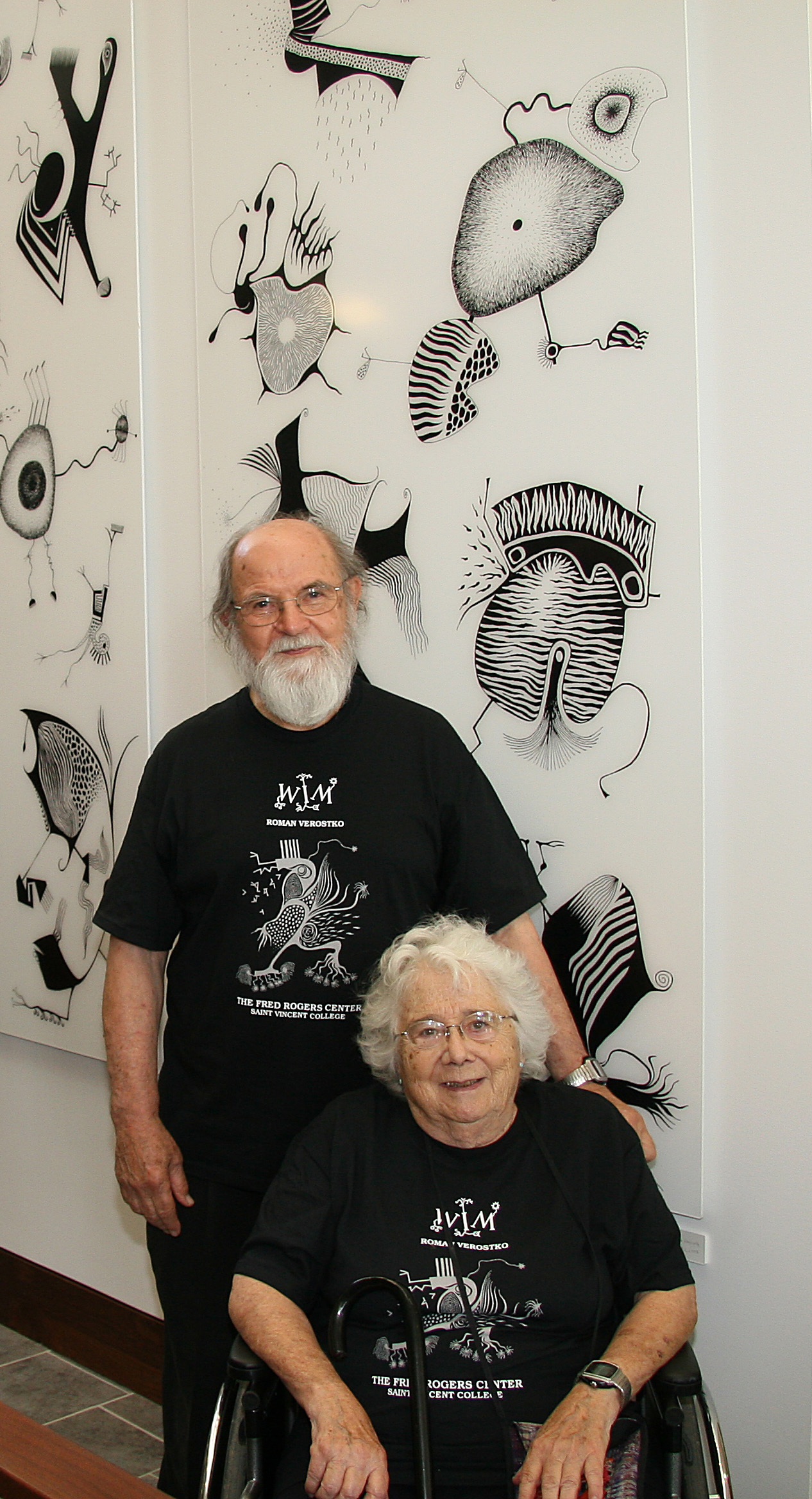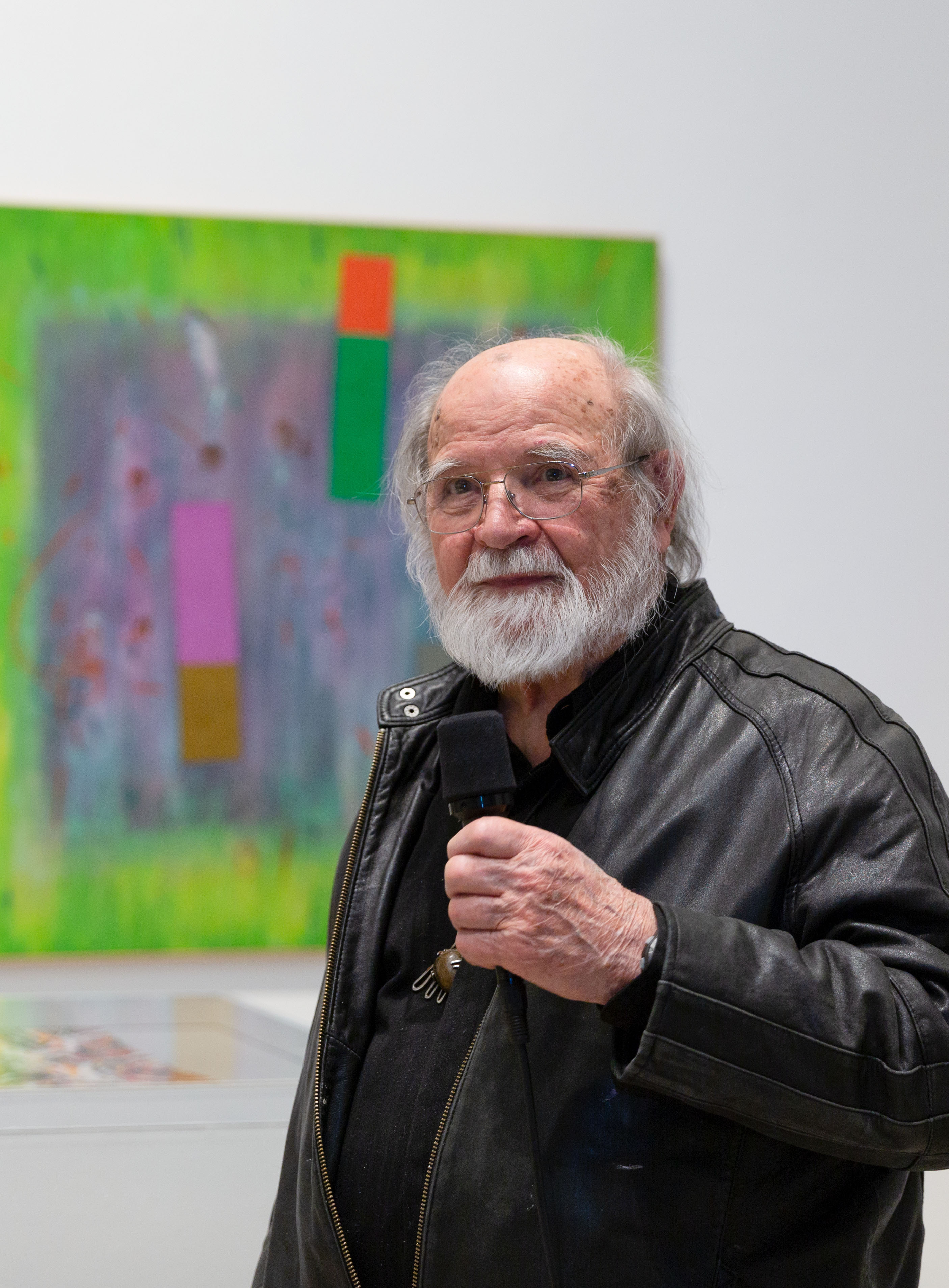Digital art pioneer Roman Verostko, 94, dies
Digital art pioneer Roman Verostko, 94, dies
-
Side Navigation
- Saint Vincent College to partner with West Penn Power Sustainable Energy Fund to bring solar-powered charging station to campus
- Verostko Center announces new exhibition featuring members of Associated Artists of Pittsburgh
- Saint Vincent College to celebrate Life in Christ Week
- December SVC grad commissioned as army officer
- SVC APB wins regional award for record fifth year in a row
- Student spotlight: Bridgette Gorg
- The European Journal of Physics accepts latest work by SVC emeritus professor
- SVC theology professor to present talk on women in the Bible
- SVC biology professor leads study of connection between alcohol and nicotine addictions
- New Bachelor of Science in “Aviation Management – Professional Pilot” takes flight at Saint Vincent College
- SVC students’ documentary “Don’t Count Us Out” wins Gold Viddy Award
- Somerset Trust donates to Saint Vincent Small Business Development Center
- National top-10 ranking for Saint Vincent’s M.S. in Criminology program
- Fall 2023 Dean's List
- SVC’s Monastery Run Improvement Project significantly improves water quality along Four Mile Run
- Saint Vincent College theology professor’s book takes a deeper look at Laudato Si’
- Alumni spotlight: Charles Farley inducted into a pair of high school coaching halls of fame
- SVC Announces 2024 Wimmer Scholarship Award recipients
- Alumni spotlight: At work and at home, Aubrey Marquis is driven by philanthropy
- SVC extends deadline for financial aid filing, Bearcat Advantage Program to May 1
- The SVC Players to present “The Sound of Music” Feb. 22-25
- Alumni Spotlight: Cameron Klos
- Pittsburgh native Dr. Ruth Langer to speak at SVC’s annual Rabbi Jason Edelstein Lecture for Catholic-Jewish Dialogue
- SVC alumnus who authored “Masters of the Air” explains backstory of his book and the Apple TV+ series
- Four students participate in mock Supreme Court argument
- Alumni spotlight: Former FBI analyst Paul Hodos discusses “Steel City Mafia,” his second nonfiction book
- Alumni Spotlight: Anne Darla Pamphile
- The Latrobe/Greensburg Homeschool Science Fair returns
- Student spotlight: Alissa Minerd
- SVC panel discussion with Federated Hermes emphasizes data science’s role in asset management
- Alumni Spotlight: Brianna Baum
- Student Spotlight: Maci Rogers
- U.S. News & World Report ranks SVC’s MS in Management: Operational Excellence a top online master’s in business program for seventh straight year
- SVC professor’s internship program aims to help continue gradual cleanup of local waterways
- SVC Concert Series to present traditional Chinese woodwind program March 15
- Education honor society welcomes new members
- SVC men’s hockey team heads to D3 national tournament after winning league championship
- Student spotlight: Julie Zhu
- Fred Rogers Institute to host Community Open House
- Expert to speak at Saint Vincent about the ethics of keeping partly rehabilitated birds in captivity
- 2024 Challenge Program registration now open
- SVC math professor enjoys “reunion” in Italy at program for commutative algebra research
- SVC physics department will conduct solar eclipse program and planetarium shows
- Student spotlight: Luca Rosato
- Alumni Spotlight: Meg Matich awarded National Endowment for the Arts Literary Translation Fellowship
- SVC holds quantum computing workshop for local STEM teachers and students
- SVC to host women in business panel discussion
- SVC hosts successful Heart of Teaching conference
- Student spotlight: Austin Slye
- SVC physics researchers search for possible effects of solar eclipse on cosmic showers
- Saint Vincent to host annual Summer Theatre gala on April 12
- Saint Vincent College to host eclipse viewing event April 8
- Saint Vincent College earns silver, bronze honors in annual Educational Advertising Awards
- Student spotlight: J’Shawn Taylor
- SVC to host presentation about Catholic Rural Ministry
- Student spotlight: Jacqueline Moon
- SVC to host 2024 senior art showcase
- Saint Vincent College announces updated plans for new athletic center
- Antique coverlet exhibit will open April 17 at Saint Vincent College’s McCarl Gallery
- SVC education department to host educator and author Dr. Todd Whitaker
- SVC welcomes Sr. Gabriele Vasiliauskaité as inaugural Stephans Family Visiting Benedictine Professor
- Saint Vincent College announces Susan Baker Shipley as Spring 2024 Commencement speaker
- News
- Mr. Safin’s “From the Heart” captures filmmaking award
- Saint Vincent College extends new student commitment deadline to June 1
- SVC to host 21st annual Academic Conference
- SVC reveals finalists for 50th annual President’s Award
- SVC student will study in Wales as part of Fulbright Summer Institute program
- Saint Vincent College to build Rhodora and John Donahue Hall to house nursing program
- SVC Concert Series continues with “(S)Heroes” from the IonSound Project
- Saint Vincent College students, faculty recognized at 2024 Spring Honors Convocation
- Olivia Persin is named 2024 SVC President’s Award winner
- Dr. Sara Lindey receives Boniface Wimmer Faculty Award
- Dr. Lucas Briola receives Quentin Schaut Faculty Award
- Alumni spotlight: Chris Golias
- Attorney Daniel Lynch, C’89, delivers 2024 Spring Honors Convocation address
- Hiring event set for 2024 Steelers training camp at SVC
- SVC communication students query Bishop Zubik during mock press conference
- Auditor General Timothy DeFoor makes recruiting pitch to students during Saint Vincent College visit
- SVC students Cameron Walker and Lauren Brennan honored at Education Department’s annual senior send-off picnic
- ‘The Marvelous Wonderettes’ kicks off Saint Vincent Summer Theatre’s 2024 season
- SVC professor receives $200,000 grant from National Science Foundation to study water desalination
- Seven SVC students participate in mock Supreme Court arguments
- Saint Vincent College students win for best statistical analysis at DataFest competition
- Saint Vincent College holds 178th Spring Commencement
- Spring 2024 commencement address by Ms. Susan Baker Shipley
- SVC engineering students cap Spring 2024 semester by presenting wind tunnel projects
- SVC graduate Dominic Oto commissioned as Army officer
- SVC alumna Elizabeth Elin wins 2024 Clark Award for religious studies and theology
- SVC is recognized as a College of Distinction
- SVC’s Dr. Tim Kelly quoted by The Associated Press
- 2024 SVC Challenge Program registration ends May 31
- SVC Birding Team participates in World Series of Birding
- Alumni spotlight: Matt Bertone
- Trip to Portugal provided SVC students and alumni with global perspective
- Saint Vincent Summer Theatre offers special trolley trip for “Unnecessary Farce”
- SVC McKenna School dean and adjunct professor honored by Boy Scouts with Trailblazer Awards
- Digital art pioneer Roman Verostko, 94, dies
- Saint Vincent College ranked among top 10 Pennsylvania colleges in 19 degree programs
- SVC President Fr. Paul Taylor listed among 2024 Trailblazers in Higher Education
- Rev. Dr. Clarence E. Wright named inaugural Fred Rogers Fellow
- Dr. Mary Regina Boland quoted by Catholic News Agency
- Student spotlight: Natalie Homison
- Dr. Mary Beth Yount chosen to fill SVC’s Irene S. Taylor Endowed Chair for Catholic and Family Studies
- 35th annual Saint Vincent College Week brings 41 Crossroads Foundation scholars to campus
- 200 campers work up a sweat during annual Steelers Youth Football Camp at Saint Vincent College
- SVC’s cybersecurity program ranked No. 3 in the country
- 43 Saint Vincent College graduates begin pursuits of advanced degrees
- Student spotlight: Marta Trembetska
- SVC chemistry professor authors chapter about scholarship of teaching and learning for STEM faculty
- Saint Vincent College honors its 2024 Alumni of Distinction
- Saint Vincent Summer Theatre’s trolley event a success
- Archabbot Rev. Martin de Porres Bartel asks ‘Where are you, America?’ in TribLive editorial
- SVC hosts computer science camp for 26 students from Young Men and Women in Charge Foundation
- Saint Vincent College professor Dr. Lucas Briola to speak about Laudato Si’
- Holy multiples! SVC professor studies occurrence of twins and triplets among canonized saints
- Alumni spotlight: Kyla Hockley
- Saint Vincent College receives approval for Direct Entry Master of Science in Nursing program
- Spring 2024 Dean’s List
- SVC hosts annual Next One Up summer camp
- Professor tends to red maple trees along Saint Vincent College’s driveway entrance
- SVC student Maggie Shero and alumna Victoria Saddler earn grand champion laurels in equestrian competition
- Alumni spotlight: Chelsea Bayko
- Saint Vincent professor’s ‘Office Hours’ TV show promotes student and professional filmmakers from across the region
- DP Harris named Saint Vincent College’s director of athletics
- Saint Vincent College earns spot on Money’s Best Colleges in America 2024 list
- Student spotlight: Valeria Hurtado
- Phineas Gage to perform free concert in Latrobe
- Fr. Justin Matro to speak at Saint Vincent Seminary as part of Benedictine spirituality series
- SVC senior legal counsel Bruce Antkowiak interviewed for documentary series ‘The Godfather of Fentanyl’
- Tradition, hospitality shine through as Steelers wrap up 2024 training camp at Saint Vincent College
- Ready to roll: Tesla joins Saint Vincent’s fleet of vehicles
- Strong turnout for Phineas Gage concert in Latrobe
- Alumni spotlight: Mandi Freger
- Saint Vincent named a College of Distinction for 2024-25
- Two exhibitions to open at Verostko Center
- Saint Vincent College hires seven faculty for 2024-25 academic year
- Saint Vincent to host performance of Chamber Orchestra of Pittsburgh and soloist Chantal Braziel, C’15
- Saint Vincent College to host forum about election process and ballot security
- Saint Vincent College physics and chemistry professors collaborate on groundbreaking research project
- McCarl Coverlet Gallery set to open ‘Flights of Fancy’ exhibit
- News
- SVC student Julien Vonovier helps coach Switzerland to bronze medal at FIBA EuroBasket 2024
- ‘Parisian Pairings’ dinner set for Oct. 9
- Four Saint Vincent College degree programs ranked No. 1 in the state by College Raptor
- Blood drives set for Sept. 18 and 19 at Saint Vincent College
- Student spotlight: Anna Taylor
- Music at Midday returns to Saint Vincent College
- Tom Cocchi, C’13, becomes president of Saint Vincent College Alumni Council
- SVC professor chosen as Memorial Foundation for Jewish Culture fellow
- Saint Vincent College selected to participate in inaugural Institute on AI, Pedagogy and the Curriculum
- Saint Vincent College rises on U.S. News & World Report Best Colleges Rankings
- Students and faculty from San Beda University in Philippines make weeklong visit to Saint Vincent College
- Gregg Brandt and Halcyon Voices featured in Saint Vincent College Concert Series
- Faculty spotlight: Marti Fusco
- Saint Vincent College reveals its 2024 Athletics Hall of Fame class
- SVC law professor quoted in Associated Press story about inmate’s 4-decade appeals process
- Saint Vincent College secures $370,000 grant from National Science Foundation
- Alumni spotlight: Chaz Coleman, C’12
- Saint Vincent College hosts annual Homecoming Weekend, announces Homecoming Queen and King
- Next Benedictine spirituality series event focuses on the Eucharist
- Saint Vincent College, Independence Health System collaborate to encourage healthcare careers
- Saint Vincent College filmmakers have scary good time in Pittsburgh 48-Hour Film Project competition
- Alumni spotlight: Delaney Fox, C’24
- Saint Vincent College cybersecurity and criminology programs earn national rankings from Intelligent.com
- Saint Vincent College’s nursing program awarded ‘most valuable’ national ranking
- SVC data science professor studies relationship between fracking chemicals and birth outcomes
- Dr. Matthew Ramage to give annual Pope Benedict XVI Lecture at Saint Vincent Seminary
- Student spotlight: Brandon Karafilis
- Saint Vincent College ranked No. 78 nationally by WalletHub
- Saint Vincent College awarded grant from Appalachian Regional Commission to boost nursing program
- Saint Vincent College secures federal grant to increase access to study-abroad and foreign language programs
- Dr. Mary Boys to speak on ‘recovering the Jewish Jesus’ in Rabbi Edelstein lecture at Saint Vincent College
- ‘Winter Sky’ and ‘Star of Bethlehem’ shows set for Saint Vincent College planetarium
- SVC Players to present ‘Pride and Prejudice’
- State trooper Trey Parsley, C’14, to speak at annual Blue Mass at Saint Vincent Archabbey Basilica
- Student spotlight: Gabbie Milcoff
- Saint Vincent College’s annual mock trial event draws 30 students from local high schools
- Prayer requests for deceased to be offered during All Souls Mass in student chapel
- Judge Mary McGinley to speak at Saint Vincent College’s Winter 2024 Commencement
- Saint Vincent College team advances to semifinals at national moot court competition
- Student spotlight: Coty Walters
- SVC History Department will mark 80th anniversary of SS Léopoldville disaster with lecture and display
- Saint Vincent College to honor former wrestling coach Tom Harbert with mat dedication at Nov. 12 season-opening dual meet
- Decline in drug use proves impact of SVC Prevention Projects
- Two students in new aviation program fly solo for the first time
- Student spotlight: Sarah Hartner
- Faculty spotlight: Father Pachomius Okogie, O.S.B.
- Saint Vincent College holds Fall Honors Convocation as part of annual Founders’ Day celebration
- Alumni spotlight: Albert Ciuksza, C’02
- Sister Nicole Kunze, O.S.B., delivers Founders’ Day reflection
- Dr. Eric Kocian receives 2024 Thoburn Excellence in Teaching Award
- SVC Wraps for Kids delivers magic of Christmas to local children
- Dr. Helen Burns receives 2024 Projektenmacher Award
- The SVC Players to present “The Sound of Music” Feb. 22-25
- Saint Vincent College law professor quoted by The Associated Press
- Alumni spotlight: Sydney Green, C’22
- Saint Vincent College hosts Society of Catholic Social Scientists conference
- Saint Vincent College earns high marks from The Heritage Foundation and Washington Monthly
- Communication Students Query Bishop Zubik in Mock Press Conference
- Faculty spotlight: Father Isaac Haywiser, C’09, S’15
- Saint Vincent College holds 20th Winter Commencement
- Saint Vincent College Winter 2024 Commencement address by Hon. Mary C. McGinley
- Saint Vincent College to offer new mathematics/actuarial science program
- McCarl Coverlet Gallery exhibit featured in Colonial Coverlet Guild of America newsletter
- Alumni spotlight: Aileen Mooney, C’11
- SVC grads' health profession school acceptance rates outpace national averages
At 94, Verostko passed away at his home in Minneapolis, MN, on June 1, 2024. Verostko’s death has been confirmed by the artist’s nephew, Jeremy Verostko.
LATROBE, PA – It is with deep sadness Saint Vincent College announces the death of digital art pioneer, educator and humanist Roman Verostko, C’55, S’59, H’21. Co-founder of the Algorist Group, Verostko is remembered as a key protagonist in the use of early computers to create works of art.
In accordance with Verostko’s wishes, a private internment will occur alongside the remains of the artist’s late spouse, Alice Wagstaff Verostko (1919–2009). Details concerning a reception for family and friends at Saint Vincent are forthcoming.
Verostko is preceded in death by his parents, John Frank Verostko and Mary Veronica Balcik, and his siblings, John Eugene Verostko, George Richard Verostko, Bernard Thomas Verostko, William David Verostko, Charles Edward Verostko, Andrew David Verostko and Theresa Dorothy Leshko.
Weeks before the onset of the Great Depression, Joseph Verostko was born in the coal mining town of Tarrs, PA, on September 12, 1929. Demonstrating an early interest in art, Verostko was schooled as an illustrator at the Art Institute of Pittsburgh before pursuing monastic life at Saint Vincent, entering the monastery on his 21st birthday in 1950 and accepting the name of Roman. Motivated by an insatiable curiosity, Verostko would earn degrees from Saint Vincent College and Seminary before his ordination to the priesthood in 1959. A year later, he was sent to New York to pursue advanced study in art history and studio practice at New York University and Columbia University before earning a Master of Fine Arts degree from Pratt Institute in 1961. Inspired by members of the New York avant-garde, he developed an experimental practice of creating abstract paintings and drawings comprised of expressive, gestural marks teeming with vitality. Later, he was appointed as the editor of The New Catholic Encyclopedia’s sections on Art and Architecture (McGraw Hill, 1967). Verostko was responsible for articulating visual styles and ideas from cultures ancient through modern to an American Catholic readership.

For Verostko, making art and discussing it had always been an extension of his spiritual life—tangible pursuits to experience the ineffable. As a result, many of the inquiries that have been central to his artistic practice originate from the formative years spent he spent at Saint Vincent.
On Aug. 11, 1968, Roman left monastic life and married Alice Wagstaff, a child psychologist and university professor. The two relocated to Minneapolis, where Verostko assumed a post on the humanities faculty at Minneapolis College of Art and Design (MCAD). While at MCAD, Verostko served in several capacities including academic dean (1975 to 1978), chairperson of Liberal Arts (1988 to 1991) and eventually professor emeritus in 1994.
In 1970, following an introduction to programming language at the Control Data Institute in Minneapolis and a summer at MIT’s Center for Advanced Visual Studies in Boston, Verostko encountered the expanding leverage of algorithms executed with computers. Within a decade, he converted his studio into an “electronic scriptorium” with computers and drawing machines known as “pen plotters.” Guided by Verostko’s algorithms, these plotters generated drawings unlike anything he had ever encountered. For him, the computer served as a pathway to new frontiers of form, and he committed his studio entirely to exploring this new frontier. Verostko would come to master the experimental process of writing computer code for creative purposes—a method of making that would occupy his studio practice for decades.

Verostko’s travels to China, first in 1982 and again in a teaching capacity in 1985 and 1998, had a remarkable influence on his development as an artist. Through a lecture tour hosted by universities throughout the country, he introduced 20th century Western art to groups of young Chinese artists eager to expand their understanding of different aesthetic traditions.
Perennially interested in semiotics, philosophy and cross-cultural exchange, Verostko’s work exists at the nexus of creativity and technological innovation. He received significant recognition from organizations that have supported the development of digital art, including a 1993 Honorary Mention for the Prix Ars Electronica; a 1994 Golden Plotter first prize (Gladbeck Germany); a Recommendatory Prize from ARTEC’95 in Nagoya, Japan; a 2009 SIGGRAPH Distinguished Artist Award for Lifetime Achievement; and induction into the inaugural class of the SIGGRAPH Academy in 2018.
Over the course of his career, Verostko’s work has appeared in over a hundred exhibitions nationally and internationally; most recently in the exhibitions Chance and Control: Art in the Age of Computers at the Victoria & Albert Museum in London, and Coder le monde at the Centre Pompidou in Paris. A prolific writer, he authored 22 published articles on subjects ranging from a 1964 paper on abstract liturgical art to his 1988 paper, “Epigenetic Painting: Software As Genotype,” delivered in Utrecht at the First International Symposium on Electronic Art identifying the biological analogues to generative art. His work is represented in numerous public and private collections, including the Minneapolis Institute of Art; Tokyo’s Tama Art University Museum; the Victoria and Albert Museum in London; and the ZKM: Center for Art and Media in Karlsruhe, Germany.
Through his pursuit of pure abstraction, electronic media, and systems of logic and language, Verostko’s creative output over the past 70 years remains vast. Saint Vincent proudly boasts the largest collection of the artist’s work in the world, spanning the entirety of his career, ranging from commissioned murals and interactive sculpture to pen-plotted drawings and time-based media projects. Additionally, Saint Vincent is home to the artist’s personal archive – an extensive repository of materials available for scholarship and curatorial projects.
“Roman represents the best of what a liberal arts education offers; the chance to learn and interpret what life can be,” said Father Paul Taylor, O.S.B., Ph.D., president of Saint Vincent College. “Saint Vincent has always been Roman’s home, and his passing represents a profound loss for those who knew him.”

On November 17, 2021, Saint Vincent formally dedicated the Verostko Center for the Arts. Located inside the Dale P. Latimer Library, the expanded 9,000 square foot state-of-the-art facility features four distinct exhibition areas, a video-presentation space, administrative offices and climate-controlled storage for Saint Vincent’s collection of art, rare books and the College’s archive. As part of the Center’s dedication festivities, Saint Vincent conferred upon Verostko an honorary doctorate of humane letters for his indelible impact within the field of generative art. Dedicated to featuring artwork that investigates intersecting academic disciplines, the Center stands as an enduring testament to Verostko’s lifelong work of revealing the existent power when fields of inquiry converge.
“Decades before computational technology would revolutionize global society, Roman recognized the power and promise of algorithmic procedure, inviting us to see the world in its increasing complexity as worthy of our investigation and reverence,” said Andrew Julo, director of the Verostko Center for the Arts and curator of the Saint Vincent Art & Heritage Collections. “As an artist, an educator and an author, Roman shaped the conversation around art and algorithms. His death represents a tremendous loss for those who continue to be impacted by his extensive work.”
In lieu of flowers, memorial contributions can be made to the Alice Wagstaff and Roman Verostko Legacy Fund at Saint Vincent College in support of interdisciplinary arts programs on campus.
ATTACHMENTS:
- Verostko in his New York studio. Photo by Robert Lax, 1960.
- To create unique gestural strokes, Verostko adapted his pen plotter to use calligraphic brushes he had acquired while teaching in China. 1993.
- Alice Wagstaff and Roman Verostko celebrating the dedication of Verostko’s WIM: The Upsidedown Mural at the Fred Rogers Center, Saint Vincent College. 2006.
- Verostko offers remarks at the opening of his retrospective exhibition, Roman Verostko and the Cloud of Unknowing. Photo by Grace Olson, Minneapolis College of Art and Design, 2019.
